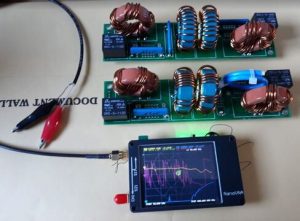Following Chris’ (G0EYO) previous article on Training for the Amateur radio Licence, Martin M7XFD describes his journey to the Foundation Licence (and beyond)
WHAT NO CW!! OR HOW I FOUND THE FOUNDATION LICENCE ..OR THE FOUNDATION LICENCE FOUND ME
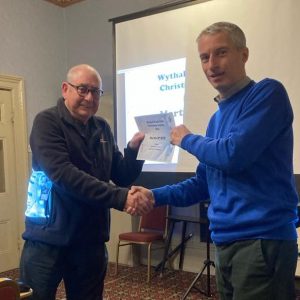
Martin (left) receiving award certificate from Lee G0MTN
Always at the back of my mind has been the idea of getting licensed as a Radio Amateur.
As a young person I was a Short Wave Listener. My father had been involved in Radar during World War II and at a very young age I discovered a crystal set in his box of ‘bits and pieces’.
We used the metal frame of my bed for the earth, strung a long wire down the garden and with a pair of ex-army headphones rotated the stiff aluminium thing with corroded vanes to pick up the BBC Light Service on the medium wave. Hearing speech and music, with no batteries or electric power involved, was sheer magic to young boy!
Following on from that we had a valve radio that had shortwave that I was able to use and added a long wire antenna. I finally bought an ex-army radio, the size and shape of the top half of a large fridge. A battleship grey Marconi 52 I think. It weighed 50lbs, had glowing valves and UV sensitive dials that also could glow in the dark. I listened to Hams around the world and I wrote to them for QSL cards to confirm I had picked up and heard their signal.
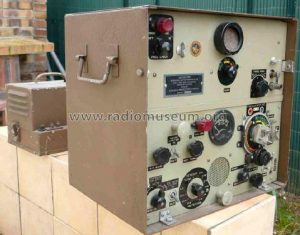
The mighty battleship grey Marconi 52
It was the CW (Morse requirements) that put me off getting my licence (sorry editor)- [Ed.unforgiveable!!]
Years flew by……….
With a career in electronics which led to computers, I retained my interest in radio and bought an airband radio that had three crystals allocated to Birmingham Airport’s Control tower, approaches and one other: (perhaps I only used two slots as the crystals were expensive.)
Living close to an airport I have updated my scanner and noticed technology changing with the advance of digital radio.
A few years ago I noticed that Wythall Radio Club ran training courses for the Amateur radio Licences and I toyed with the idea of finally becoming licensed.
Time passed. I gained another handheld receiver.
Some of my post-retirement hobbies changed, freeing up time, and in the summer of last year I emailed the club to inquire if I could get involved. As a result Chris G3YHF invited me to a talk at Wythall House in September and a few weeks after that to a ‘Plug and Play’ Open day in the fields at Wythall Community Centre.
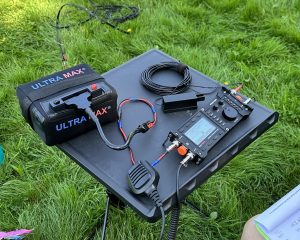
G3YHF’s neat portable CW Plug and Play table
I was not the only prospective new member so the talk was on Amateur Radio in the modern world of today. What struck me was that despite the decline in numbers of active Hams , the focus has shifted to pursuing different ways of doing things in this digital age and the technical challenges within the hobby. I could see this as a way of finding out what would interest me most.
I took my wife to the open day so she could understand better what I was thinking about getting into. She had a good time and could see the range of interests and the camaraderie involved. The fact that every rig and antenna set-up was portable was good for me to see as my main interest is in handheld and portable systems. ‘How much is it going to cost?’, she said. ‘Oh not much’, I replied. ‘There are very cheap handheld radios from China’.
Neil,G1TZC , taking time out from his satellite dish, reassured me that Morse code was not mandatory and showed me a copy of the Foundation licence manual, explaining me that studying and taking the exam was straightforward especially given my background in electronics. Other Club members encouraged me to have a go and again I checked : definitely no CW requirement!!
I sent for the manual from the RSGB the next day.
Wythall Radio Club do not run their own courses anymore as most of the courses have gone on-line, so in September and October I took the Essex Ham course and passed my Foundation Licence in November last year.
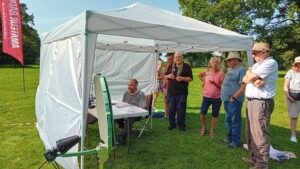
Neil’s Pop- up shack with captive audience . (Martin in there somewhere?)
From contacting a Wythall Radio Club to being licensed took less than three months.
To reassure those that might be thinking of getting into the hobby, even taking the exam itself was a pleasant experience as there is a pre-exam chat with a person who is also a keen radio amateur and the same person is on hand to facilitate the online exam session.
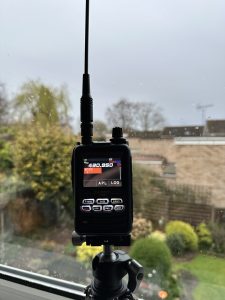
Martin’s current rig
I traded my scanners in for a very good Handheld radio transceiver (right). Even though I could get something much cheaper this was going to be my sole equipment for a while. As you will recall I said I wanted portability rather than a fixed set-up at home
However to get more coverage, with advice from Ian M0LQY, I have subsequently put together a hotspot. With the handheld radio I have three options. I can make contacts directly locally and on the move, via near and sometimes far repeaters, or through the hotspot over the internet. With the latter I can make contacts all over the world, but I have enjoyed most being able to contact club members directly and via the Wythall repeater. I am also getting to know other Radio Amateurs locally and further afield – sometimes as I pass by on my travels
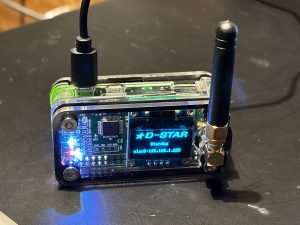
MMDVM Pi-Star Rig
It was seeing a YouTube video on a ham using a Handheld radio and a hotspot in his house, contacting the World that was one of the triggers to contact WRC which led on to the Foundation Licence.
To continue to extend my knowledge I am now studying for the Intermediate Exam which is taking longer, but equally enjoyable.
For me Amateur Radio has so much a lot to offer.
I am enjoying VHF/UHF and surprising world wide contacts when I want. With the summer coming then HF with a portable set up may be something to try.
Shall I learn morse code? … I am not rushing!! (you never know Ed. !!)
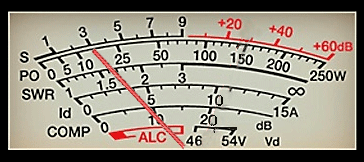
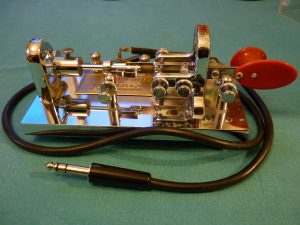 Having owned a Vibroplex in the past, I was intrigued to see him clip a clothes peg on to the vibrating ‘dots’ arm during our qso.
Having owned a Vibroplex in the past, I was intrigued to see him clip a clothes peg on to the vibrating ‘dots’ arm during our qso. 

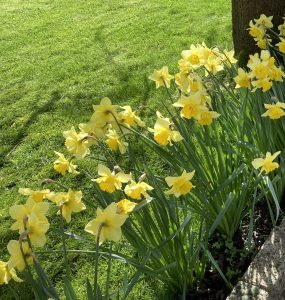
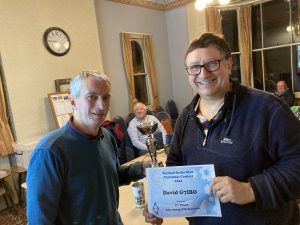 Lee GoMTN made remote QSOs from Poland, Munich, and the centre of Birmingham, using his mobile phone to access his home rig. There was much greater use of CW, with 5 members active most days.
Lee GoMTN made remote QSOs from Poland, Munich, and the centre of Birmingham, using his mobile phone to access his home rig. There was much greater use of CW, with 5 members active most days. 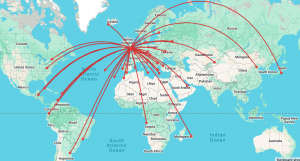
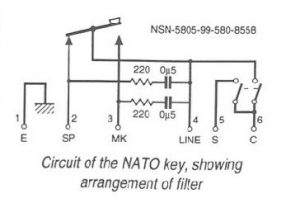 And not just CW operating! Chris G0EYO has continued the restoration of his historic Morse code key collection…. as
And not just CW operating! Chris G0EYO has continued the restoration of his historic Morse code key collection…. as 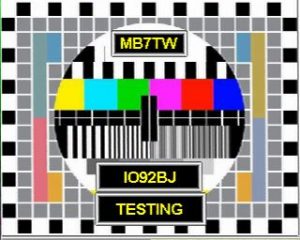
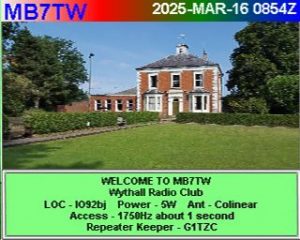 Wythall Radio Club is pleased to announce its new SSTV repeater is now live on-air.
Wythall Radio Club is pleased to announce its new SSTV repeater is now live on-air.








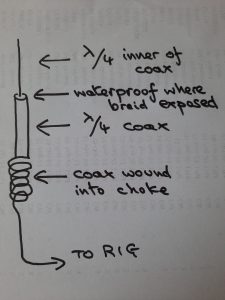 It comprises a quarterwave radiator made from the centre of a length of coax, below which is a quarterwave of complete coax that is then wound into an rf choke. The tail of the coax beyond the choke forms the feeder.
It comprises a quarterwave radiator made from the centre of a length of coax, below which is a quarterwave of complete coax that is then wound into an rf choke. The tail of the coax beyond the choke forms the feeder.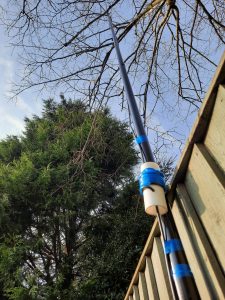
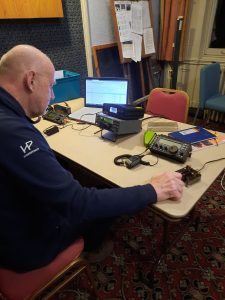 The top scorers were John 2E0XET with a stupendous 3543 miles/watt for his 1-watt CW QSO with Virginia USA and Lee G0MTN’s 713 miles/watt from his 10-watt digital contact with Argentina.
The top scorers were John 2E0XET with a stupendous 3543 miles/watt for his 1-watt CW QSO with Virginia USA and Lee G0MTN’s 713 miles/watt from his 10-watt digital contact with Argentina.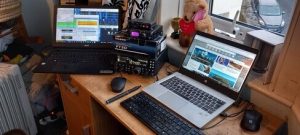 Down in devon, Kev started off using 10 watts of FT8 but then dropped down to 5 watts for the last 2 weeks to see what could be achieved.
Down in devon, Kev started off using 10 watts of FT8 but then dropped down to 5 watts for the last 2 weeks to see what could be achieved. 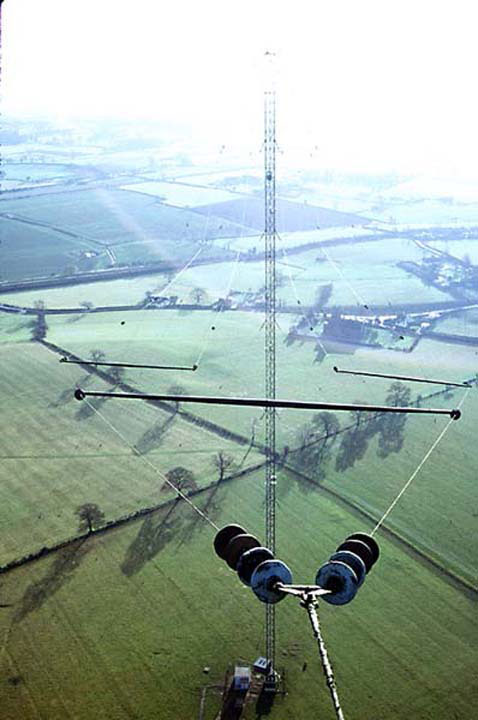

 At lunchtime, I couldn’t receive this beacon – but instead the
At lunchtime, I couldn’t receive this beacon – but instead the 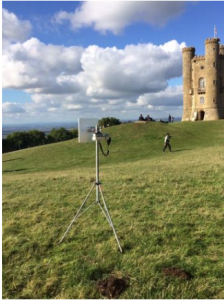 Do want to know how to use cheap drone transmitter/receivers to get on 5.7GHz? – the photo shows one in operation at Broadway Tower.
Do want to know how to use cheap drone transmitter/receivers to get on 5.7GHz? – the photo shows one in operation at Broadway Tower.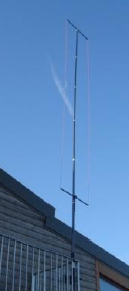 Or with more activity on the HF bands as we approach the solar cycle peak, perhaps you’d like to build a small profile ‘C’-beam for 20m using easily available plastic conduit?
Or with more activity on the HF bands as we approach the solar cycle peak, perhaps you’d like to build a small profile ‘C’-beam for 20m using easily available plastic conduit?